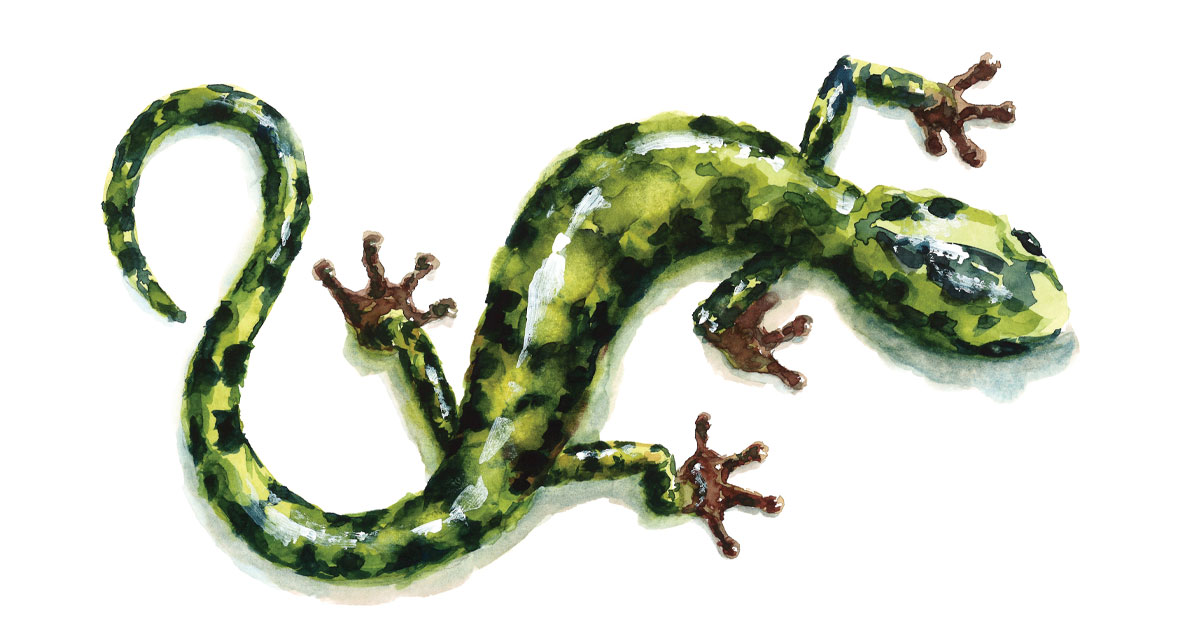The diversity of North Carolina’s three sub-biomes, namely the coastal plains, Piedmont, and the mountains, includes varieties of forest and non-forest ecosystems. Based on our consistent levels of precipitation and four distinct seasons, we live in the biome of a temperate deciduous forest. It’s no wonder our climate attracts diverse species of colorful birds and smaller mammals, as well as dangerous creatures, from the rattlesnake to the southern black widow spider. In the mountain regions, outside Winston-Salem, live black bears, bobcats, and coyotes. And, perhaps the cougar is not extinct, but resurging in numbers. Unless searching for specific birds, insects, aquatic vertebrae or mammals in the Piedmont Triad, you’ll not be aware of the names of creatures that no longer fly, swim, or walk. In calling all defenders of wildlife, however, it’s essential to know why our ecosystem is on the verge of losing the green salamander.
The Typical Salamander
Curiosity encourages a child to follow the path of fast-moving, long-tailed creatures that resemble a cross between a frog and a lizard. With similar long, slender bodies and smooth, moist skin, it’s easy to confuse salamanders with geckos and skinks. The latter have special toe pads to scurry up and down walls and even hold themselves upside down. The salamander, on the other hand, enjoys wet locations. Some have lungs, while others have gills. Isn’t it amazing that some species, like the two-foot-long hellbender, are fully aquatic and breathe through their skin? Including frogs and toads, 56 species of salamanders living in North Carolina belong to the Amphibia classification.
A Description of the Green Salamander
Most likely, you have never glimpsed the rare, green salamander. It defies the typical definition. Its head and body are flat, shaped like a rectangle, with long legs that jut outward. Although the body is dark in coloring, it possesses bright green or yellow patches to blend in with its typical environment of moist, lichen-covered rocks and mossy tree branches. A unique characteristic, special tips on its webbed, enlarged toes, eases the effort needed to climb trees or rocky, sandstone cliffs. Upon meeting a predator, such as a snake, juveniles utilize a defense mechanism that lessens into adulthood: they can secrete poisonous toxins through the dorsal area which spread over their skin, and kill predators when being digested.
On the Endangered List
It seems peculiar to believe that a creature which has survived 12 million years is on a “critical,” endangered species list. About an hour from Winston-Salem, between Boone and Asheville, lives the Hickory Nut Gorge green salamander. Through developmental stages, it takes roughly eight years to mature sexually, within a lifespan of 15 years. Despite females producing 10 to 30 eggs every other year, it must still survive maturity. For example, while mountain climbers and hikers who come across the ancient, lungless salamander and find it unique, they may also decide to capture it for a pet.
Become a Wildlife Protector
The job of scientists and conservationists may sound extraordinary: tracking through thickets of rhododendrons or attempting to squeeze through crevasses of wet rock. But the task of locating rare creatures is not easy. Scientists believe that the green salamander has adequate food supplies to eat—small invertebrates, including arachnids, insects, snails, and slugs. The impact on its status is caused rather by logging. Its nature is to remain concealed, protected by large rocks and trees; therefore, once the forest changes, the salamander can die from the dramatic changes in its temperature.
How to Help!
Education is an empowering tool for understanding the interconnectedness of the food chain. From the smallest microorganism to giant trees, each of us can learn how to help all ecosystems. Becoming a wildlife protector begins in your yard. Start by reading about our endangered species in North Carolina. Help turtles cross unsafe areas with supervision and do not take wild creatures home. Grow a garden to welcome pollinators and plant native trees!
You can protect vulnerable species from extinction. Knowing who is on the list and making changes to aid all creatures is a step forward!
Next Month: The Barn Owl



















